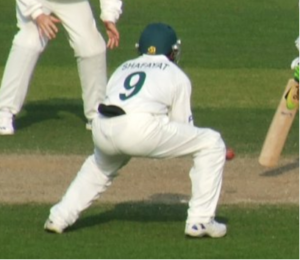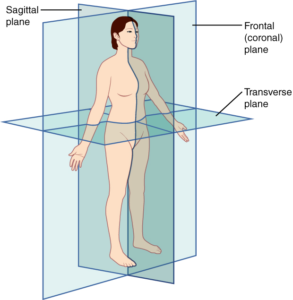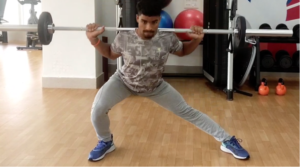For starters, as you move around, you are moving around and operating in a 3-dimesional existence, where your movements operate in one of, or a combination of, 3 planes of movement. Most everyday movements will require movement, or at the very least some stability, in all 3 planes. As cricket is a very dynamic part of life, it would make sense that this point is particularly important.
Cricket requires movements in all 3 planes of movement, only with the added factor of more complex movements, executed at a breakneck speed, all whilst other people around you are trying to stop you from effectively performing your task. Therefore, it is important to condition and strengthen in all 3 planes of movement. So firstly, what are the 3 planes?
The 3 planes of movement (or motion) are;
– Frontal Plane: The frontal plane (or coronal plane) divides the body into front and back, and the most common movements in this plane are sideways movements, known as abduction (limbs moving further away from the body) and adduction (limbs being brought in closer to the body.) The most well-known example of an exercise in this plane would be a lateral shoulder raise (dumbbell out to the side.) The easiest movement to think of in cricket would be shuffling sideways ways when fielding.

– Sagittal plane: The sagittal plane divides the body into right and left, and common movements in this plane are the up and down movements known as flexion and extension. This is the most commonly exercised plane in just about all strength training programs. There are plenty of common examples of exercises in this plane, but a squat or a bicep curl are 2 of the most commonly known ones.
– Transverse Plane: The transverse plane is also sometimes referred to as the horizontal plane, and divides the body into upper and lower halves. All movements in this plane are rotational in nature, and occur in all the joints throughout the body. This is the least exercised plane, and is hardly worked at all in most routines. This is the plane of motion in which the most common injuries occur, particularly ankle sprains. Any kind of rotation-based exercise would fit (at least in some part) into this plane of movement. Batting, bowling and throwing all have significant rotational components to them.
When considering the 3 planes of movement, refer to the picture below, and imagine a big sheet of glass splitting the body in half, and imagine your limbs having to move along the glass whilst performing a particular movement. This is how to determine which plane/s you are moving in.

The reason that this is so relevant to a strength training program as it applies to cricket is because most strength training programs that are being done around the place involve exercises and routines that are very sagittal plane dominant. This is despite the fact that cricket certainly isn’t sagittal plane dominant.
Key Point: Movements and tasks in cricket occur in all 3 planes of motion at the same time – so condition accordingly
Just a quick extension as an example; you may be thinking ‘I do squats and deadlifts for my legs, they are functional’, and indeed these 2 exercises have become synonymous with ‘functional training’ in recent times. And they are great exercises. However, despite being fantastic full body exercises that work your whole body from head to toe, and require your core and stabiliser muscles to control the weight as well as require you to provide for the movement, these 2 exercises are performed completely in the sagittal plane. I will keep referring back to squats and deadlifts as an example, and question just how functional they are (they are….but how far down the functional continuum exactly?)
Another little interesting fact is that the majority of non-contact injuries that occur in sports occur in the transverse and frontal planes, yet the number of exercises that are done to train in these 2 planes are almost completely inverse, or opposite (that is the majority of strength training is done in the sagittal plane.) A very interesting relationship to say the least. In some texts and papers, the number of non-contact injuries occurring in these 2 planes are up around the 80% mark, whilst the number of exercises or time spent training in the sagittal plane is also up around a similar level. In fact, I would estimate that 90% of strength training I see done at gyms around the place are exercises done in the sagittal plane. This figure is obviously made worse as a result of all the bodybuilding or useless ‘mirror training’ that occurs by people only interested in the look. But even the athletes that I see training are only marginally better in terms of the 3 planes, despite the fact that their exercises are more movement focused.
Key Fact: Approximately 80% of orthopedic injuries occur in the transverse and frontal planes, (yet over 80% of time strength training is spent training in the sagittal plane.)
So keep the images of the 3 planes imprinted in your head, and with every exercise, think about which plane or planes you are in, as well as how many planes you are using, because the more planes that are incorporated into an exercise, the better it is.
Its not only about injury reduction, but also performance too
When it comes to developing strength, and then more specific expressions of power, these abilities are very movement specific or task specific. It would go without saying that just because you are very strong on the bench press, doesn’t mean that you will be very strong on the squat – as they are very different movements. This is probably obvious as they are different parts of the body. But more closely related are squats and lunges – and it has been shown that the carryover from double-leg strength to single leg strength is not particularly high. That is, just because someone is powerful in the squat movement, does not mean they will be powerful in the lunge movement. Similarly, just because someone is quite proficient with step ups or walking lunges, does not mean they will have a similar level of stability, strength and coordination in lateral step ups and multi-directional lunges. In other words, if building a base of functional strength in which you can power to improve on movements such as decelerating and changing directions when running, or turning to run back the other way down the wicket, you must condition with movements that train in this same plane, rather than purely squatting for example, which as we mentioned earlier, falls very much into the sagittal plane. This is not saying squats are not good, they are – and they will allow you to lift more maximal weight that lunging or stepping variations will, but they should be combined with exercises that also hit the other planes.


So keep the images of the 3 planes imprinted in your head, and with every exercise, think about which plane or planes you are in, as well as how many planes you are using, because the more planes that are incorporated into training program, the more carryover to game day it has, and the better it is.

Cricket Athlete
